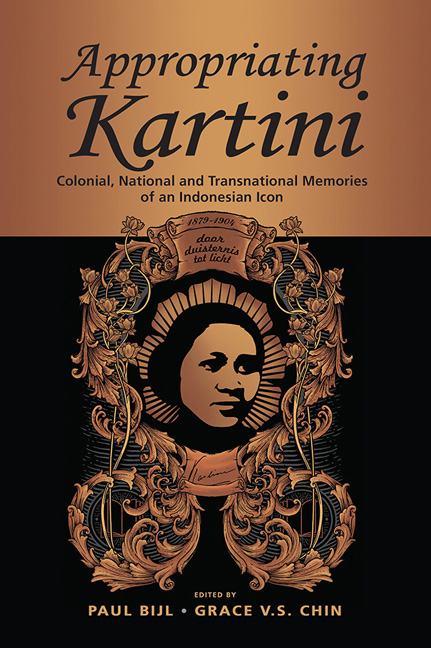Book contents
- Frontmatter
- Contents
- Acknowledgments
- The Contributors
- 1 Introduction
- 2 Crafting Reform: Kartini and the Imperial Imagination, 1898–1911
- 3 Hierarchies of Humanity: Kartini in America and at UNESCO
- 4 Ambivalent Narration: Kartini’s Silence and the Other Woman
- 5 Unpacking a National Heroine: Two Kartinis and Their People 103
- 6 Call me Kartini? Kartini as a Floating Signifier in Indonesian History
- 7 Kartini and the Politics of European Multiculturalism
- 8 Afterword
- Index
3 - Hierarchies of Humanity: Kartini in America and at UNESCO
Published online by Cambridge University Press: 02 April 2020
- Frontmatter
- Contents
- Acknowledgments
- The Contributors
- 1 Introduction
- 2 Crafting Reform: Kartini and the Imperial Imagination, 1898–1911
- 3 Hierarchies of Humanity: Kartini in America and at UNESCO
- 4 Ambivalent Narration: Kartini’s Silence and the Other Woman
- 5 Unpacking a National Heroine: Two Kartinis and Their People 103
- 6 Call me Kartini? Kartini as a Floating Signifier in Indonesian History
- 7 Kartini and the Politics of European Multiculturalism
- 8 Afterword
- Index
Summary
Introduction
In her book on the invention of human rights in the course of the eighteenth century, Lynn Hunt offers an analysis of the type of person that is considered “human” in European modernity. She discusses the crucial relationship between autonomy, empathy and human rights by stating that “[t]o have human rights, people had to be perceived as separate individuals who were capable of exercising independent moral judgment” and as “able to empathize with others” (Hunt 2007, p. 29). However, Hunt writes, not everybody was deemed to have such a moral autonomy and deep inner life: children, slaves, servants, the propertyless, women and, we can add, colonized peoples were seen as lacking the right qualities to be deemed (fully) human. Kartini was well aware of the privileges of being identified as human. Her connections with Dutch feminists and socialists were complex, for whereas these two groups primarily fought their battles in terms of gender and class, race
was a different category altogether as it was largely unacknowledged by the international women's movement of the late nineteenth and early twentieth centuries (Rupp 1997). Unfazed by this extra challenge, Kartini engaged proactively with international discourses on humanity, human equality, human inequality and rights by constructing in her letters an empathetic, wilful inner life that made her part of what was at the time considered “humanity” (Bijl 2017). On 20 May 1901, she wrote to her socialist-feminist pen pal, Stella Zeehandelaar, in her characteristically ambiguous tone which hovers somewhere between admiration, irony and anger:
Seeing that in enlightened Europe, the centre of civilization, the source of Light, the struggle for the right of women is still being fought so fiercely and furiously, can we expect that the Indies, which has been in deep slumber for centuries and which is still asleep, would accept, would permit, that women, who throughout the centuries have been looked upon as inferior beings and have been treated as such, see themselves as humans who have the right to an independent conscience? (Kartini 1911, p. 154; Kartini 2014, p. 196. original emphasis)
Hunt's emphasis on empathy, autonomy and human rights was perfectly captured by Kartini when six months later on 20 November 1901 she wrote to Mrs Abendanon-Mandri: “I learned three things from the Europeans. Love, pity, and the concept of right—I want to live according to them” (Kartini 1987, p. 98; Kartini 2014, p. 226).
- Type
- Chapter
- Information
- Appropriating KartiniColonial, National and Transnational Memories of an Indonesian Icon, pp. 46 - 72Publisher: ISEAS–Yusof Ishak InstitutePrint publication year: 2020

